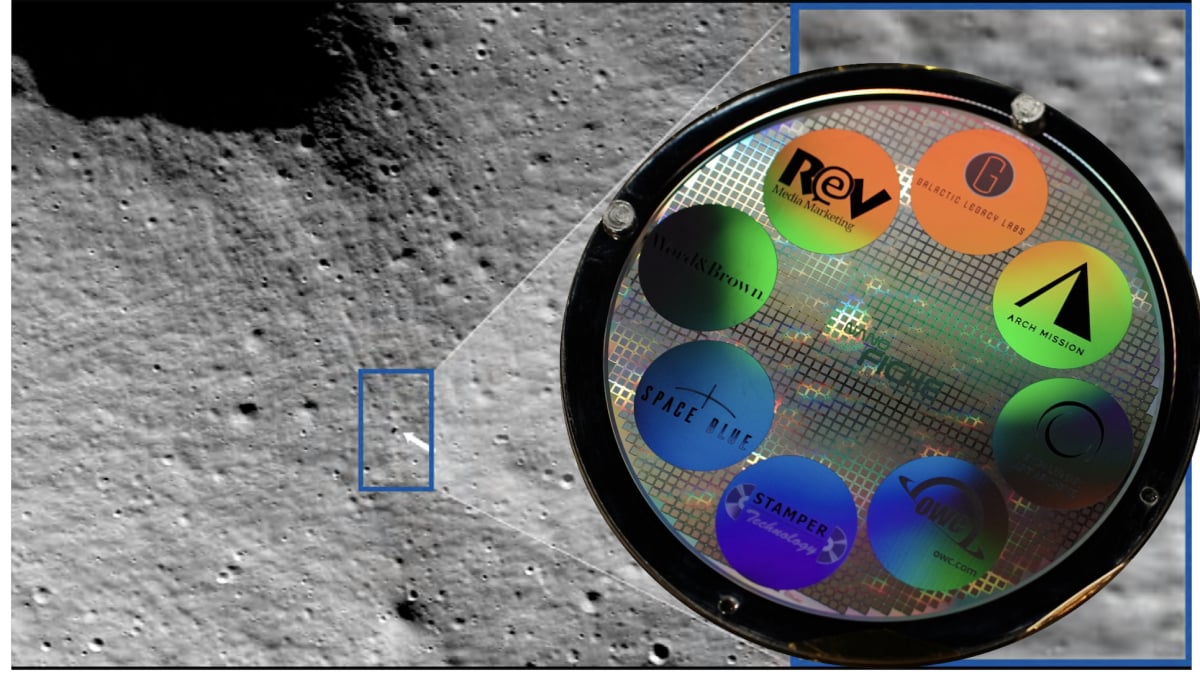Entertainment
There’s a library on the moon now. It might last billions of years.

Until 2024, our lunar neighbor didn’t offer much in the way of reading material.
Just four sentences were etched on old NASA landers, two on Apollo 11 and two on Apollo 17, both with Richard Nixon’s signature. Other visible words include a memorial to fallen astronauts and logos on equipment (including Alan Sheperd’s golf balls). One visitor donated a book — astronaut David Scott says he left his Bible atop a lunar rover in the Sea of Showers — but 53 years’ worth of sunlight and gamma rays (which bombard the moon and break down paper) will not have left it in readable condition.
Then in late February, the moon received a massive donation of books — some 30 million pages’ worth, to be precise. Also in the collection: 25,000 songs and a whole bunch of art.
How? Well, that groundbreaking lander Odysseus didn’t merely deliver money shots from the moon’s south pole, and it won’t just be remembered for tipping over during landing. Something that landed right-side up is the first ever repository of human culture on a world beyond Earth. The Galactic Legacy Archive is its official name — but informally, we’re more likely to think of it as the moon library.
No books can be checked out of this library. The pages are etched in nickel, on thin layers so tiny that you need a microscope to read them. (Forget microfiche, this is nanofiche). A good chunk of the archive, the digital part with music and images, requires that you read the nickel-etched primer on digital encoding.
But it’s on one small disk that can fit in your hand, and that’s one giant leap for library-kind. “Nickel never decays and never corrodes,” explains Nova Spivack, head of the nonprofit Arch Foundation that was making its third attempt to deliver the first off-Earth library. (This time it partnered with a company called Space Blue, which added more than 70,000 digital artifacts from 222 Earth artists.)
“We can now say for the first time in history that civilization will not be lost.”
Now that it’s in place, providing the tiny disks don’t suffer a highly unlikely direct hit from a meteorite, the library “will last for as long as the moon,” Spivack says. (Scientists’ current greatest guess: the moon will stay in Earth orbit until the sun turns into a red giant, in 5 billion years’ time). “Even if our planet is destroyed in a nuclear war, it’ll still be there. We can now say for the first time in history that civilization will not be lost.”
The Arch Foundation’s multi-year mission: place Galactic Legacy Archives all over Earth and around the solar system. It’s good to have multiple backups. But what are we humans choosing to preserve, and what does it say about us? Spivak gave Mashable an exclusive look. Here are six highlights that future generations, or alien civilizations, might find in the moon library. Some of it is sublime, some of it ridiculous — a bit like the thing it aims to represent.
1. The earliest art.

A cave painting with images of hands.
Credit: The Arch Foundation
Cave paintings go back at least some 45,000 years. This early form of art was often a collaboration between generations centuries apart (such as the hands in the Cueva de las Manos in Argentina, above, painted in waves between 7,300 BC and 400 AD). Thanks to this new wave of collaboration, copies of hundreds of cave paintings exist on the moon – the same moon those hunter-gatherers would have seen most nights of their lives.
Mashable Light Speed
It’s fair to say they never imagined their digits would be compressed into digital files and blasted on a rocket to that mysterious orb.
2. A version of Wikipedia … that makes Elon Musk look good?
The moon library contains what you might call an extremely offline version of Wikipedia, out of date long before it was sent. This English version’s 6 million articles were downloaded by the Arch Foundation in 2021, though the 10,000 most-read entries were updated in 2022.
What does that mean? Well, for one thing it means the version of Elon Musk on the moon – his Wikipedia entry – is forever frozen in time before his disastrous takeover of Twitter. Any aliens finding this archive will think of Musk as the richest person in the world (instead of, as he currently is, the third) and will wonder what he’s doing as an encore after the rockets and the EVs. Let that sink in.
3. Dogecoin.
Back in 2021, Dogecoin fans put together a tune about sending their favorite currency “to the moon.” Houston, we regret to inform you that the crypto has landed.
Not in the way the crypto bros intended, of course. Dogecoin’s price hasn’t gotten close to its 2021 high, let alone rocket higher. But now, along with Bitcoin and Ethereum, the specs and design for this meme-based coin are literally on the lunar surface. Billions of years from now, the human race may have perished – but that side-eye shiba will live on.

Some of the crypto-inspired art and detailed specs listed in the library.
Credit: The Arch Foundation
4. 25,000 songs in your pocket.
What do Jimi Hendrix, Chuck Berry, Bob Marley, Janis Joplin, and The Who have in common? They’re not just rock legends, they’re rock legends who made it to the moon, man. Space Blue formed a partnership with Melody Trust, a company that owns the rights to the masters for some 25,000 classic rock tunes in the library; there’s a special focus on 1969 recordings to commemorate the first moon landing.
Rock fans can also rejoice at the fact that among the many images in the digital archive is Pink Floyd’s iconic Dark Side of the Moon album cover. “See you at the south pole of the moon” doesn’t quite have the same ring to it, but that’s where you’ll find ’em.
5. David Copperfield’s magic secrets.

You may not be able to see the Great Wall of China from the moon, but you will be able to see how David Copperfield “walked through” the wall in 1986.
Credit: CBS
“If you want to know how I’m going to make the moon disappear, go up there and check it out.” So said magician David Copperfield to Space.com about a supposed upcoming performance that has yet to be announced. Perhaps Copperfield is waiting a while after the moon made its own spectacular performance by totally blocking the sun across a swathe of the U.S. – who’d want to follow that?
Regardless, Copperfield’s archive is contained in the library: all the details of his famous illusions, including the ones he performed at the Statue of Liberty and the Great Wall of China. Whether those artifacts last as long as the moon library remains to be seen.
6. Materials for worship … including Dune
Every kind of civilization-rebuilding text you can imagine is part of the archive, courtesy of the Long Now Foundation, an institute creating long-term cultural libraries. So is every language known to the Rosetta Project, an archive of all known languages. Religions are well represented: the Bible, the Torah, the Koran, the Hindu Vedas and Upanishads, and Buddhist scriptures all live on the moon now. There are images and stories from indigenous traditions on six continents.
Plus thousands of beloved novels, Spivak says: “If it’s an important book, it’s there … Harry Potter, the Foundation Trilogy, Lord of the Rings, Dune.” Wait, Dune? The story of a young aristocrat who becomes a God Emperor conquering billions of worlds? Let’s hope we don’t accidentally give the aliens any ideas.
-

 Business7 days ago
Business7 days agoUnitedHealth says Change hackers stole health data on ‘substantial proportion of people in America’
-

 Business6 days ago
Business6 days agoTesla’s new growth plan is centered around mysterious cheaper models
-

 Business5 days ago
Business5 days agoXaira, an AI drug discovery startup, launches with a massive $1B, says it’s ‘ready’ to start developing drugs
-

 Business5 days ago
Business5 days agoUK probes Amazon and Microsoft over AI partnerships with Mistral, Anthropic, and Inflection
-

 Entertainment3 days ago
Entertainment3 days agoSummer Movie Preview: From ‘Alien’ and ‘Furiosa’ to ‘Deadpool and Wolverine’
-

 Business6 days ago
Business6 days agoTwo widow founders launch DayNew, a social platform for people dealing with grief and trauma
-

 Business4 days ago
Business4 days agoPetlibro’s new smart refrigerated wet food feeder is what your cat deserves
-

 Entertainment6 days ago
Entertainment6 days agoTesla’s in trouble. Is Elon Musk the problem?




























